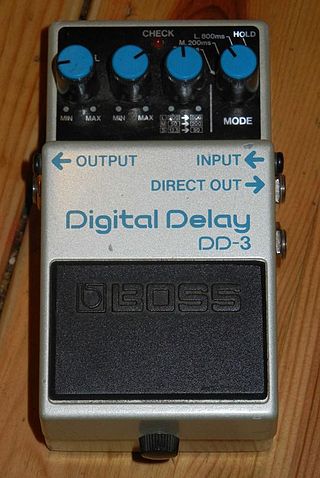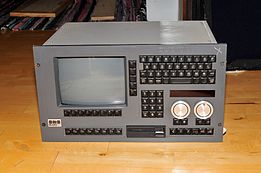
A mixing console or mixing desk is an electronic device for mixing audio signals, used in sound recording and reproduction and sound reinforcement systems. Inputs to the console include microphones, signals from electric or electronic instruments, or recorded sounds. Mixers may control analog or digital signals. The modified signals are summed to produce the combined output signals, which can then be broadcast, amplified through a sound reinforcement system or recorded.

A digital audio workstation (DAW) is an electronic device or application software used for recording, editing and producing audio files. DAWs come in a wide variety of configurations from a single software program on a laptop, to an integrated stand-alone unit, all the way to a highly complex configuration of numerous components controlled by a central computer. Regardless of configuration, modern DAWs have a central interface that allows the user to alter and mix multiple recordings and tracks into a final produced piece.
Solid State Logic (SSL) is a British company based in Begbroke, Oxfordshire, England that designs and markets audio mixing consoles, signal processors, and other audio technologies for the post-production, video production, broadcast, sound reinforcement and music recording industries. SSL employs over 160 people worldwide and has regional offices in Los Angeles, Milan, New York, Paris, and Tokyo, with additional support provided by an international network of distributors. Solid State Logic is part of the Audiotonix Group.

The Hit Factory is a recording studio in New York City owned and operated by Troy Germano.
A variable-gain (VGA) or voltage-controlled amplifier (VCA) is an electronic amplifier that varies its gain depending on a control voltage.

AMS Neve Ltd is a privately owned audio engineering company who specialise in digital and analogue music consoles, outboard equipment and post production consoles. AMS Neve was the result of the amalgamation in 1992 of AMS with Neve Electronics.
Neve Electronics was a manufacturer of music recording and broadcast mixing consoles and hardware. It was founded in 1961 by Rupert Neve, the man credited with creating the modern mixing console.
TASCAM is the professional audio division of TEAC Corporation, headquartered in Santa Fe Springs, California. TASCAM established the Home Recording phenomenon by creating the "Project Studio" and is credited as the inventor of the Portastudio, the first cassette-based multi-track home studio recorders. TASCAM also introduced the first low-cost mass-produced multitrack recorders with Simul-Sync designed for recording musicians, and manufactured reel-to-reel tape machines and audio mixers for home recordists from the early 1970s through the mid-1990s. Since the early 00's, TASCAM has been an early innovator in the field-recording and audio accompaniment to video with their DR-series recording platforms. TASCAM celebrated its 50th anniversary in 2021.

An aux-send is an electronic signal-routing output used on multi-channel sound mixing consoles used in recording and broadcasting settings and on PA system amplifier-mixers used in music concerts. The signal from the auxiliary send is often routed through outboard audio processing effects units and then returned to the mixer using an auxiliary return input jack, thus creating an effects loop. This allows effects to be added to an audio source or channel within the mixing console. Another common use of the aux send mix is to create monitor mixes for the onstage performers' monitor speakers or in-ear monitors. The aux send's monitor mix is usually different from the front of house mix the audience is hearing.

Delay is an audio signal processing technique that records an input signal to a storage medium and then plays it back after a period of time. When the delayed playback is mixed with the live audio, it creates an echo-like effect, whereby the original audio is heard followed by the delayed audio. The delayed signal may be played back multiple times, or fed back into the recording, to create the sound of a repeating, decaying echo.
Gated reverb or gated ambience is an audio processing technique that combines strong reverb and a noise gate. The effect is often associated with the sound of 1980s British popular music. It was developed in 1979 by producer Steve Lillywhite and engineer Hugh Padgham while working on Peter Gabriel's self-titled third solo album, after Phil Collins played drums without using cymbals at London's Townhouse Studios. The effect is known for demonstrating in Collins' hit song "In the Air Tonight".
Founded in 1973, Raindirk Audio Ltd is a manufacturer of high-end, pro-audio equipment used in both recording studios and live sound reproduction. Raindirk's first console was sold to former Deep Purple singer Ian Gillan's Kingsway Studios. All products are designed by Cyril Jones.

The Neve 8078 was the last of the "80 series" hand-wired analogue mixing consoles designed and manufactured by Neve Electronics, founded in 1961 by the English electronics engineer Rupert Neve, for high-end recording studios during the 1970s. Some were custom built for major studios like CBS Sony.

Metalworks Studios is a music recording studio in Mississauga, Ontario, Canada. It was established in 1978 by Gil Moore of the Canadian rock group, Triumph. Over a span of 40 years, Metalworks has been the recipient of Canadian Music Week's 'Studio of the Year' 17 times. Since 1978, Metalworks Studios has expanded into a six studio facility offering in-house tracking, mixing and mastering, as well as video editing and DVD authoring.

In professional audio, a digital mixing console (DMC) is a type of mixing console used to combine, route, and change the dynamics, equalization and other properties of multiple audio input signals, using digital signal processing rather than analog circuitry. The digital audio samples, which is the internal representation of the analog inputs, are summed to what is known as a master channel to produce a combined output. A professional digital mixing console is a dedicated desk or control surface produced exclusively for the task and is typically more robust in terms of user control, processing power and quality of audio effects. However, a computer can also perform the same function since it can mimic its interface, input and output.

Onkio Haus Inc. is a company operating sound recording, mixing and mastering studios in Ginza, Tokyo, owned by Magazine House, Ltd and others. It also provides video editing and postproduction services for TV program and commercial film projects. The studio is renowned as one of the best professional recording studios in Japan, used for recording and mixing Japanese popular songs and jazz music.
Arthur Rupert Neve was a British-American electronics engineer and entrepreneur, who was a pioneering designer of professional audio recording equipment. He designed analog recording and audio mixing equipment that was sought after by professional musicians and recording technicians. Some of his customers were music groups The Beatles, Aerosmith and Nirvana, and recording studios Sound City Studios and Abbey Road Studios. Companies that he was associated with included Neve Electronics, Focusrite, AMS Neve, and Rupert Neve Designs.
In music recording, mix automation allows the mixing console to remember the audio engineer's adjustment of faders during the post-production editing process. A timecode is necessary for the synchronization of automation. Modern mixing consoles and digital audio workstations use comprehensive mix automation.

The Institute of Audio Research (IAR) was an educational institution in New York City. Students of IAR were offered a wide variety of academic programs in the field of music production and audio engineering. Students could choose from courses in audio electronics, digital music production, mixing music, and audio processing and storage, among others. It was founded in 1969 and closed in 2017. It has resurfaced as part of Five Towns College in 2022.
The Solid State Logic SL 4000 is a series of large-format analogue mixing consoles designed and manufactured by Solid State Logic (SSL) from 1976 to 2002. 4000 Series consoles were widely adopted by major commercial recording studios in the 1980s.












